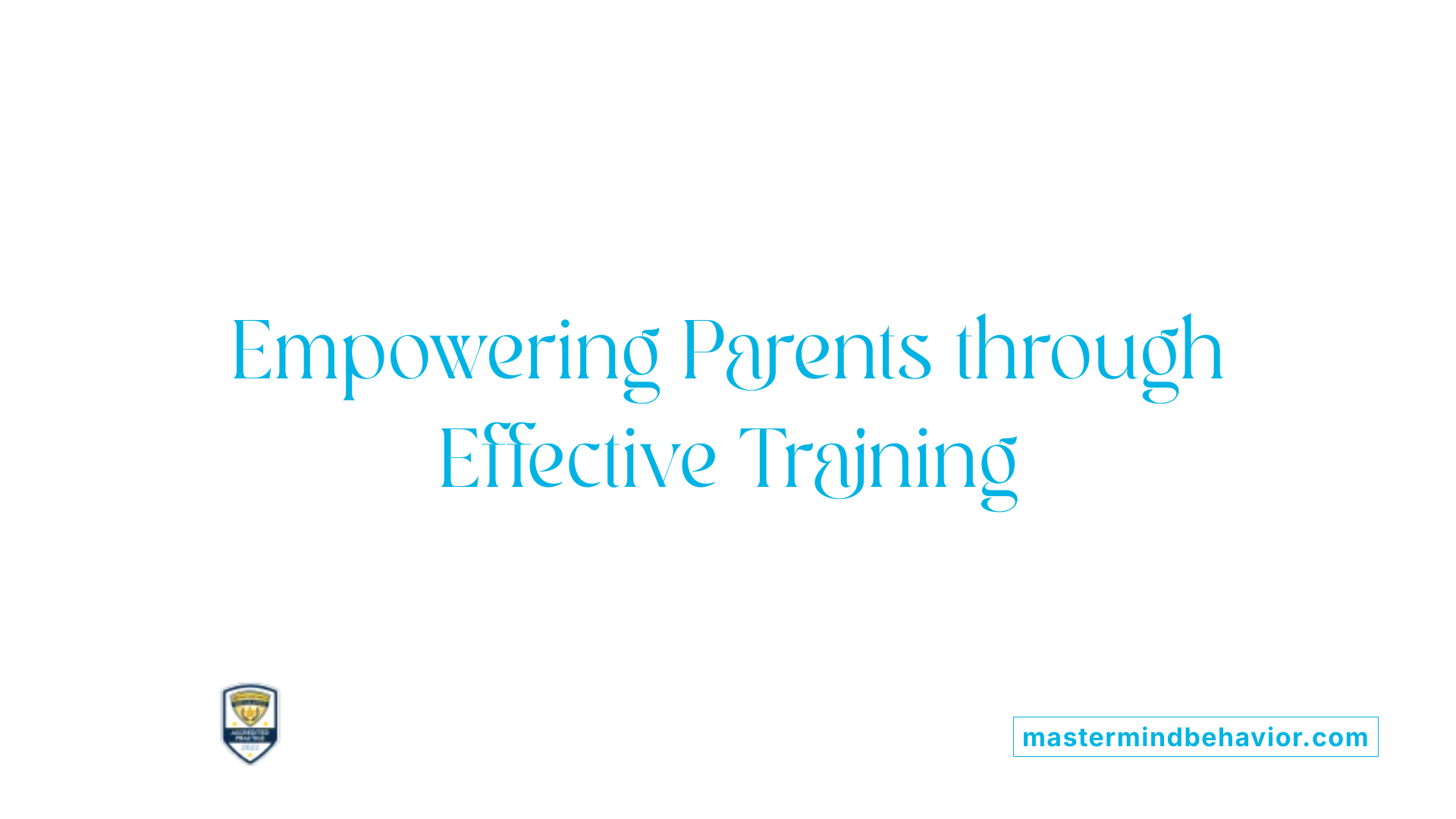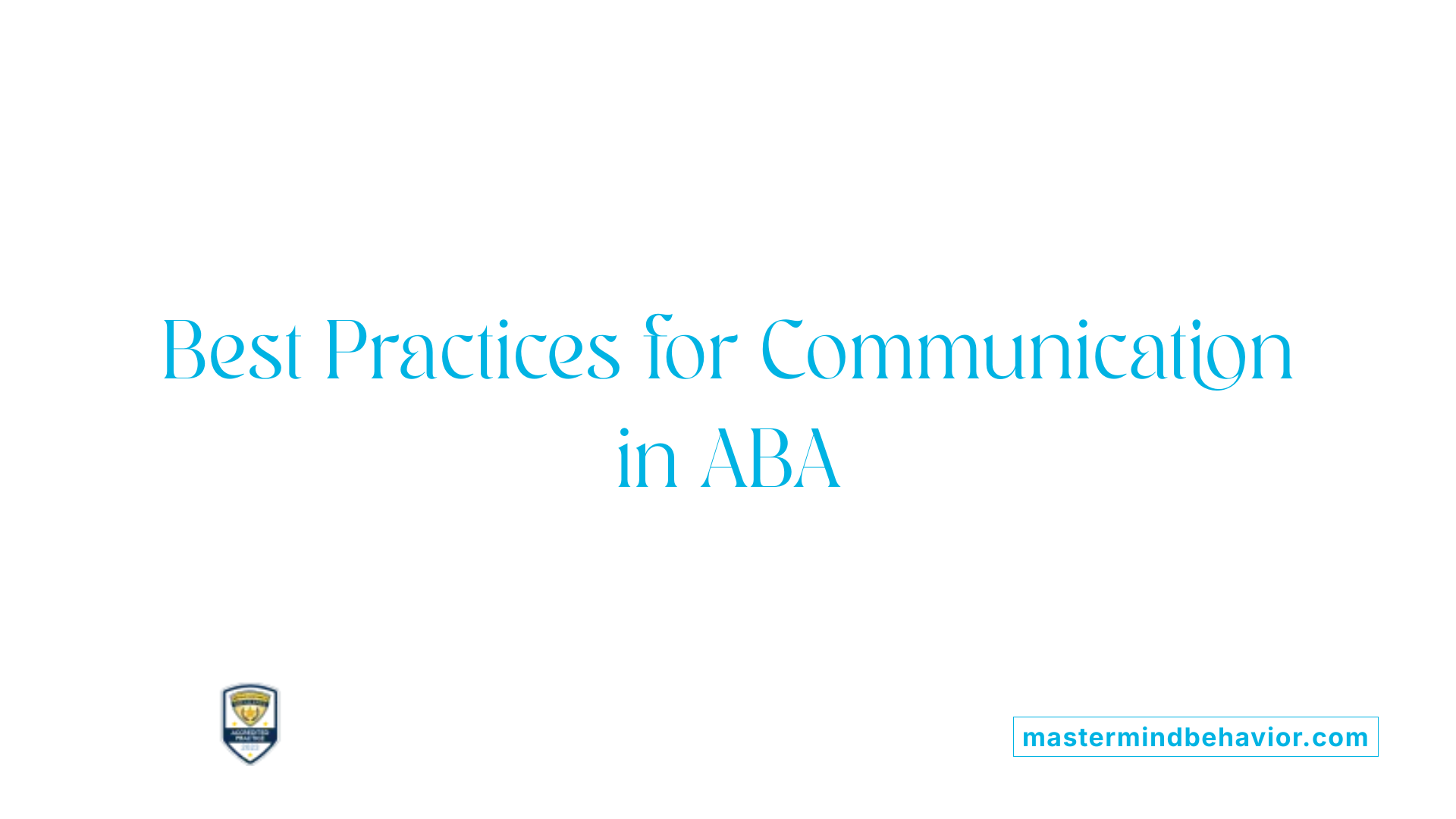The Benefits of Parent and Teacher Collaboration in ABA Therapy

Introduction
Parent and teacher collaboration in Applied Behavior Analysis (ABA) therapy is a game-changing approach that strongly influences the outcomes for children with autism spectrum disorders and other developmental challenges. By working together, parents and educators create a consistent, supportive environment that extends beyond traditional therapy settings, ensuring the generalization and retention of skills. This narrative explores the numerous benefits, best practices, and strategies of effective collaboration, emphasizing how it transforms the therapeutic journey for children and their families.
The Power of Consistent Application Across Environments

Impact of consistent application of ABA techniques across different settings
Consistency plays a vital role in the success of Applied Behavior Analysis (ABA) therapy, especially in helping children with autism spectrum disorders thrive. When parents actively engage in implementing ABA techniques both at home and in school, children experience a more seamless transition of skills learned in therapy to their everyday lives.
Active parental involvement ensures that strategies are applied uniformly across different environments. This consistency helps children internalize the skills they learn, promoting their independence and enhancing their social interactions. Without parental engagement, children may struggle to generalize these skills when faced with new situations, such as playdates or community outings.
Benefits of generalization of skills
The generalization of skills learned in therapy is critical for a child's long-term success. By applying what they learn in therapy to various environments, children develop stronger adaptive behaviors. The benefits include:
- Improved Independence: Children learn to manage daily tasks without constant supervision.
- Enhanced Social Skills: Effective communication and interaction with peers become more natural in different settings.
- Behavioral Consistency: Children demonstrate desired behaviors consistently, reducing instances of challenging behaviors.
Collaboration between parents and ABA therapists further enhances this generalization process. As parents communicate regularly with therapists about their child's progress, both parties can refine strategies to address specific challenges. This partnership not only supports skill retention but also fosters a stronger bond and understanding between parents and children, creating a nurturing environment for development.
By consistently applying ABA techniques across all areas of a child's life, parents help their children achieve better outcomes, reinforcing the importance of their engagement in the therapeutic process.
Why Collaborative Efforts are Fundamental in ABA Therapy

Significance of collaboration among parents, teachers, and ABA therapists
Collaboration is essential in Applied Behavior Analysis (ABA) because it creates a robust support network for children undergoing therapy, especially those diagnosed with Autism Spectrum Disorder (ASD). By integrating families, clinical teams, and various health professionals, a holistic treatment approach is established, which tailors interventions to each child’s unique needs.
In this collaborative environment, parents play a crucial role not only as caregivers but as active partners in the therapeutic process. Their involvement allows for blending home strategies with those utilized in therapy sessions, ensuring consistency. Parents are trained to implement strategies learned in therapy, leading to improved skill generalization across settings, from home to school and social interactions.
How this collaboration enhances the effectiveness of interventions
Effective collaboration involves constant communication and shared goals among all parties involved, including ABA therapists, teachers, and parents. This teamwork ensures that everyone is aligned in supporting the child’s development, which is particularly beneficial during regular assessments and adjustments of treatment plans.
Additionally, when parents work closely with teachers, they can reinforce learned skills in educational contexts, enhancing student engagement and ensuring that interventions are consistently applied. Research shows that children with involved parents often achieve better behavioral outcomes. This partnership not only maximizes the child’s progress but also empowers parents, increasing their confidence in advocating for their child’s needs. Overall, the improvement in communication and teamwork significantly contributes to the success of ABA therapy, fostering positive behavioral changes and a nurturing environment that supports children's growth.
Enhancing Therapeutic Success Through Parent Training

Role of Parent Training in ABA Therapy
Parent training in Applied Behavior Analysis (ABA) therapy is pivotal for facilitating children's progress. By providing parents with knowledge about autism and the necessary therapeutic strategies, it empowers them to effectively address their child's needs. Parent training enables caregivers to implement tailored approaches that promote skill generalization across various environments, such as at home, school, or other social settings.
The two primary components of this training include parent education and individualized hands-on strategies. The former gives parents an understanding of ABA principles, while the latter equips them with specific techniques for day-to-day implementation. This dual focus helps parents actively participate in their child's therapeutic process, which research indicates is linked to improved skills retention and behavioral outcomes.
How Does Parent Training Benefit ABA Therapy?
Parent training is crucial in enhancing the effectiveness of ABA therapy. By equipping parents with therapeutic techniques, it allows them to reinforce positive behaviors at home and in community settings, promoting greater independence for their children. Research shows that when parents are actively involved in the training, there is better retention of these behaviors outside the clinical environment.
Additionally, parent training fosters improved communication between parents and children, strengthening their bond and reducing instances of negative behaviors. Techniques like Positive Reinforcement and the Picture Exchange Communication System (PECS) can be effectively implemented by parents, creating a consistent learning environment that benefits the child's development.
Benefits Derived from Parents' Active Participation
The active engagement of parents in ABA therapy is linked to a variety of benefits:
- Improved Goal Progress: Children show accelerated progress in achieving their therapeutic goals when parents are involved.
- Strengthened Parent-Child Relationships: Enhanced communication techniques not only improve behavior management but also deepen emotional connections.
- Increased Parental Confidence: Parents gain the skills necessary to advocate for their child's needs, further enriching their involvement in educational settings.
- Consistent Strategy Application: Active participation ensures that treatment strategies are consistently applied at home, thereby reinforcing therapy gains in everyday life.
In summary, parent training in ABA therapy stands as a foundation for nurturing the development and independence of children with autism, driving success through collaboration.
Parents and Teachers: A Duo for Enhanced Outcomes

What are the benefits of parent and teacher collaboration in ABA therapy?
The benefits of parent and teacher collaboration in ABA therapy are significant for enhancing children’s learning and development. It promotes consistency in strategies across different environments, helping children generalize the skills they learn, which leads to better behavioral outcomes.
Parent training in ABA equips caregivers with the tools they need to apply techniques effectively at home, thus fostering strong relationships and improved communication between parents and educators. This collaboration ensures that everyone is on the same page regarding the child's goals and progress, allowing for tailored interventions that suit individual needs.
| Benefits of Collaboration | Description | Impact |
|---|---|---|
| Consistency in Strategies | Aligns techniques used at home and school | Enhances skill generalization |
| Empowerment of Parents | Trains parents in ABA techniques | Improves parental confidence and effectiveness |
| Clear Communication | Establishes regular updates between parents and teachers | Facilitates adaptive interventions |
| Reduces Parent Stress | Shared responsibilities and strategies alleviate pressures | Lessens anxiety related to child’s development |
| Improved Quality of Life | Better support systems for families | Enhances emotional well-being for all involved |
Overall, this teamwork contributes to increased skill retention, reduced stress for parents, and improved quality of life for families, ultimately leading to successful outcomes in the growth and development of children with ABA therapy.
Empowering Parents: Essential Roles in ABA Therapy
How do parent roles impact outcomes for children with special needs?
Parent roles significantly impact outcomes for children with special needs by serving as advocates and essential partners in the transition process. Their involvement in educational and transition planning promotes better academic and social outcomes, particularly when they collaborate closely with teachers and therapists. Parents also help shape their children's values and expectations regarding independence, which is crucial for their social integration.
Effective interventions that include parent training and support have been shown to enhance children's cognitive, language, and socioemotional development, improving their readiness for school. Moreover, a nurturing home environment, strengthened by parental involvement, boosts children's confidence and self-esteem, leading to better overall well-being.
Strategies to empower them in ABA environments
There are several strategies to empower parents within ABA environments:
- Parent Training Programs: Offering parents comprehensive training on ABA principles equips them with the skills needed to manage their child's behavior effectively.
- Collaboration with Therapists: Establishing open lines of communication between parents and ABA therapists helps ensure consistent implementation of strategies at home and during therapy sessions.
- Customized Strategies: Therapists can provide tailored techniques that consider each child’s unique needs, promoting skill generalization in various contexts such as school and community.
- Establishing Trust: By fostering a collaborative partnership built on mutual respect, parents feel more confident in advocating for their children’s needs.
- Support and Resources: Encouraging parents to engage with community resources and other families dealing with similar challenges can enhance their support network and stress management abilities.
By empowering parents through training and active collaboration, children with special needs benefit from a consistent approach that reinforces learned behaviors and skills, ultimately leading to improved outcomes.
Strategies for Effective Communication and Collaboration

What communication strategies facilitate collaboration in ABA therapy?
Effective communication is a cornerstone of successful collaboration in ABA therapy. Here are some strategies that facilitate this process:
- Augmentative and Alternative Communication (AAC): Tools like Picture Exchange Communication System (PECS) and Speech Generating Devices (SGDs) empower children with autism to express their needs, fostering clearer communication in therapy contexts.
- Assessment of Communication Skills: Applied behavior analysts evaluate each child’s communication capabilities to tailor intervention plans that directly address their unique needs.
- Positive Reinforcement: Reinforcing desired communication behaviors encourages children to utilize new skills effectively, making interactions more productive.
- Prompting and Fading Techniques: These methods support independence by gradually reducing assistance as the child learns to communicate more autonomously.
- Social Skills Training: Teaching children about conversational engagement and social cues is essential for enhancing their interactions with peers and adults.
These strategies not only improve both expressive and receptive language abilities but also support better communication outcomes and collaboration across various settings.
Building effective partnerships between parents and educators
Fostering a strong partnership between parents and educators is vital for students receiving ABA therapy. Here are some foundational elements:
- Establish Clear Communication: Set up regular communication channels like emails or scheduled meetings. This timing allows parents and educators to align on a child’s progress.
- Regular Updates and Feedback: Provide consistent updates on behavioral changes observed at home and in school. This shared information helps in adapting teaching strategies to better fit the child's evolving needs.
- Collaborative Goal Setting: Involve both parents and educators in creating personalized goals for the child using SMART criteria. This ensures that everyone is working towards common objectives.
- Empathy and Respect: Approach conversations with a positive attitude, recognizing and respecting each other's perspectives for a better understanding of the child's needs.
By creating a trusting environment, parents and educators can work together effectively to support children’s development and apply consistent strategies across different contexts.
Facilitating Successful Parent-Teacher Partnerships
What are the best practices for effective parent-teacher collaboration in ABA therapy?
Effective parent-teacher collaboration in ABA therapy hinges on open communication and continuous dialogue among all involved parties. This includes ABA therapists, educators, and parents. By coordinating discussions and sharing insights, they ensure the implementation of consistent strategies that unite their approaches toward shared goals.
Parents are instrumental in this collaboration by modeling and reinforcing skills learned in therapy at home. They provide essential feedback that helps educators align their classroom strategies with therapeutic goals. This strengthens not only the skills children learn during therapy but also promotes their generalization across different environments, enhancing independence in various settings.
A vital aspect of effective collaboration is cultivating strong relationships. Regular check-ins and meetings establish an atmosphere of trust and understanding, where challenges can be promptly addressed. This team-based approach fosters a community of support for the child’s development.
Additionally, leveraging each member's expertise is crucial. Parents bring insights about their child’s preferences and behaviors, while teachers share knowledge about the child’s social interactions and academic progress. This pooling of resources allows for comprehensive and personalized treatment plans that better serve the child's unique needs.
Lastly, promoting active listening and empathy within the team strengthens collaboration. This respect for each member’s perspective helps maintain aligned objectives and creates a nurturing environment conducive to the child's growth.
ABA Strategies for Parents: Practical Tools for Everyday Challenges
What are some effective ABA strategies for parents?
Effective ABA strategies empower parents to support their children's learning and manage challenging behaviors. Here are some practical tools to implement:
- Positive Reinforcement: Encourage desired behaviors by rewarding your child. This could be through praise or tangible rewards, especially when they successfully complete tasks.
- Visual Schedules: Use visual schedules to outline daily activities, helping children anticipate what’s coming next and easing transitions.
- Timers: Implement timers to signal countdowns for changes in activity. This can provide your child with a sense of predictability.
- Social Stories: Create social stories to explain specific situations and expectations. These can help reduce anxiety and prepare children for new experiences.
- Task Analysis: Break down complex tasks into smaller, more manageable steps. This method aids children in learning each component before tackling the entire task.
- Modeling Behaviors: Consistently demonstrate appropriate behaviors for your child to emulate, reinforcing the learning process. This can be particularly effective when establishing routines.
Implementing these strategies to reinforce children’s learning
To ensure the success of these strategies, consistency is crucial. Parents should actively integrate these methodologies into daily routines, making adjustments as needed based on their child’s specific needs and responses.
Additionally, collaborative discussions with ABA therapists can refine the techniques being used at home, ensuring that they align with therapy goals. This partnership can enhance the effectiveness of strategies, allowing for a seamless application across various settings like home and school.
When parents feel equipped with these techniques, they promote a nurturing environment that supports their child's emotional and behavioral development, ultimately leading to better learning outcomes.
Conclusion
The integral partnership between parents and teachers in ABA therapy transforms the landscape of treatment for children with special needs. Their collaborative efforts provide a comprehensive support system that enhances the child’s ability to learn and apply new skills in various settings. By pooling their knowledge and resources, parents and educators foster an environment of consistency and encouragement that nurtures children’s growth and independence. This partnership not only optimizes therapeutic outcomes but also builds lasting relationships among all stakeholders, ultimately improving the quality of life for children and their families.
References
- Why Parent Training in ABA is Critical to Success
- The Importance of Parent Training in ABA - Compleatkidz
- Collaborating with Teachers for ABA Success
- The Crucial Role of Parents in ABA Therapy - Illinois Autism Center
- Benefits of Parent Training in ABA Therapy
- Parent Collaboration in ABA Therapy
- Collaborating with ABA Therapists: How Parents Can Support...
- The Benefits of ABA Therapy for Parents
Recent articles

The Role of Joint Attention in Language and Social Skills Development
Understanding the Critical Impact of Joint Attention in Early Childhood Development

The Importance of Parent Training in Autism Therapy Programs
Empowering Parents: The Key Role of Training in Autism Care

The Role of Visual Supports in ABA Therapy Strategies
Unlocking Communication and Independence in ABA Therapy

How Early Intervention Can Improve Outcomes for Children with Autism
Unlocking Potential: The Impact of Early Autism Intervention

How ABA Therapy Supports Children in Developing Flexibility and Adaptability
Empowering Independence: How ABA Therapy Nurtures Growth and Change

How Caregiver Education Empowers Families of Children with Autism
Unleashing the Power of Knowledge: Transforming Lives of Families with Autism


